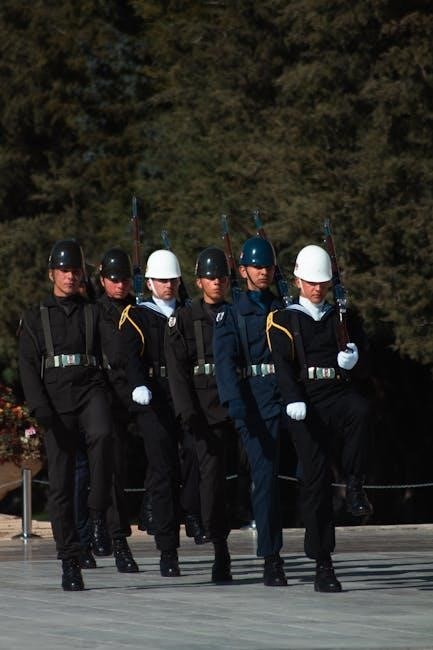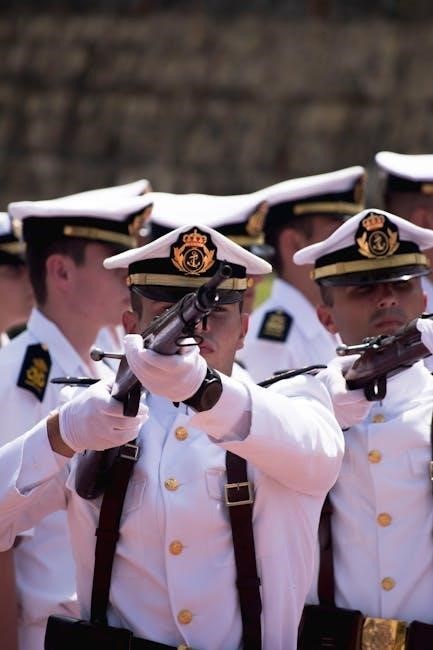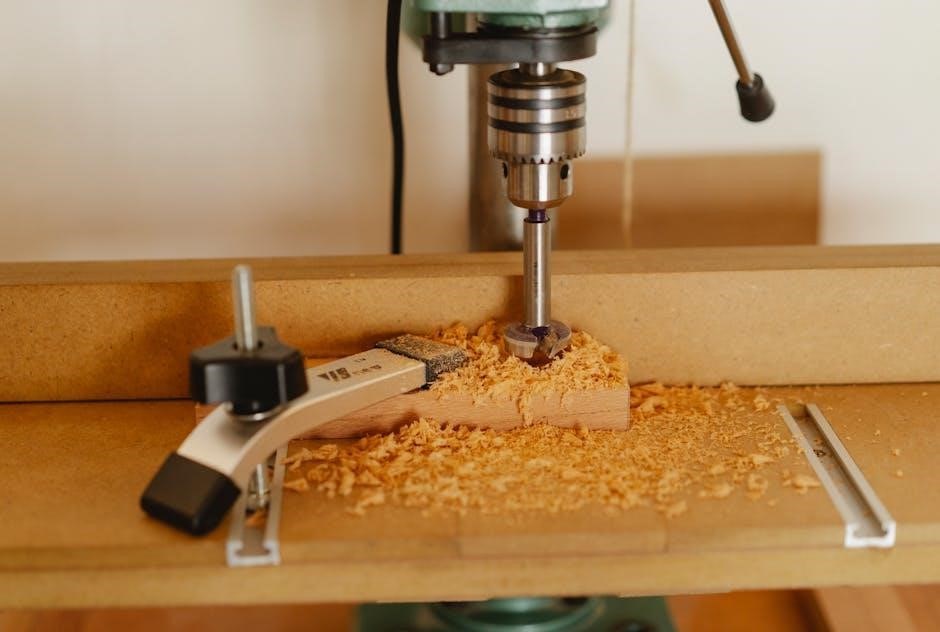The Navy Drill Manual is an official publication by the Naval Education and Training Command, providing standardized procedures and protocols for drill training․ It outlines foundational aspects such as positions, movements, and commands, ensuring uniformity across all units․ The manual is regularly updated to reflect modern naval standards and practices, making it an essential resource for both cadets and instructors․
1․1 Purpose of the Navy Drill Manual
The primary purpose of the Navy Drill Manual is to establish standardized procedures and protocols for drill training, ensuring uniformity and precision across all naval units․ It serves as a comprehensive guide for instructors and cadets, outlining foundational movements, commands, and safety protocols․ The manual aims to foster discipline, teamwork, and esprit de corps while preparing personnel for ceremonial and operational roles․ It also provides a framework for evaluating drill performances, ensuring adherence to naval traditions and contemporary standards․ This resource is essential for maintaining the professionalism and readiness of naval personnel․
1․2 Historical Background of Navy Drill Manuals
The Navy Drill Manual has a rich historical background, evolving from traditional military practices to modern standardized protocols․ Originating from early naval ceremonies and formations, the manual has been refined over centuries to reflect changing operational needs․ Historical documents, such as the Royal Navy’s 18th-century drill books, influenced its development․ The manual’s structure and content have been shaped by significant events, including World War II, which emphasized precision and discipline․ Today, it remains a cornerstone of naval training, blending historical traditions with contemporary practices to ensure efficiency and professionalism in drill exercises․
1․3 Key Components of the Navy Drill Manual
The Navy Drill Manual comprises essential components that ensure standardized training and execution․ It includes detailed sections on basic positions and movements, such as “Attention” and “Ready,” which form the foundation of drill exercises․ The manual also covers command structures, specifying the timing and delivery of orders․ Additionally, it addresses safety protocols to prevent injuries during training․ Uniform regulations and ceremonial procedures are outlined, emphasizing precision and discipline․ These components collectively ensure that all personnel perform drills uniformly, upholding the Navy’s traditions and operational excellence․

Foundational Aspects of Navy Drill
Navy Drill establishes the core skills and discipline required for military precision․ It includes basic positions like “Attention” and “Ready,” and fundamental movements such as “Present Arms,” ensuring alignment and uniform execution․
2․1 Basic Positions and Movements
The foundation of Navy drill begins with basic positions and movements, which are essential for discipline and uniformity․ These include the position of Attention, where the body is straight, heels together, and hands at the sides․ The Ready position involves bending the knees slightly and holding the rifle or sword at a specific angle․ Movements like Present Arms and Shoulder Arms are executed with precision, emphasizing control and alignment; Proper execution ensures safety and maintains the integrity of drill exercises, fostering a culture of professionalism and teamwork among personnel․
2․2 Command Structure and Execution
The command structure in Navy drill is hierarchical, ensuring clear communication and execution; Drill instructors issue verbal commands, which must be followed precisely to maintain discipline and safety․ Commands are divided into preparatory and executive parts, with actions executed on the executive command․ Hand signals may also be used to enhance clarity․ Proper execution relies on understanding the command structure and adhering to protocols, fostering a culture of professionalism and accountability among personnel․ This systematic approach ensures synchronized movements and achieves the desired outcomes of drill training effectively․
2․3 Safety Protocols in Drill Training
Safety protocols in Navy drill training are critical to prevent injuries and ensure a secure environment․ Cadets are instructed in proper techniques for handling drill rifles and equipment to minimize risks․ Emergency procedures, such as responding to accidents or equipment malfunctions, are clearly outlined․ Supervision by trained instructors is mandatory, and cadets are required to report any safety concerns․ Regular safety briefings and drills are conducted to reinforce these protocols, ensuring compliance with established standards and maintaining a culture of safety and accountability during all training exercises․

Drill Competitions and Evaluations
Drill competitions and evaluations assess precision, teamwork, and adherence to Navy drill standards․ They promote excellence, fostering camaraderie and showcasing unit cohesion through synchronized performances and strict judging criteria․
3․1 Types of Drill Competitions
Navy drill competitions include close order drill, color guard, and rifle exhibitions․ These events showcase precision, teamwork, and adherence to drill manual standards․ Ceremonial drills, such as guard mounting and parade performances, are also common; Competitions may feature individual or team events, with evaluations based on synchronization, command execution, and overall presentation․ These events foster unit pride and excellence, preparing personnel for formal ceremonies and operational readiness․ They emphasize discipline, coordination, and the mastery of drill techniques outlined in official manuals․
3․2 Evaluation Criteria for Drill Performances
Drill performances are evaluated based on precision, alignment, and adherence to manual standards․ Judges assess command execution, timing, and uniformity of movements․ Proper posture, facial expressions, and coordination are also critical․ Teams are scored on synchronization, with penalties for errors such as missteps or improper weapon handling․ Evaluations emphasize strict compliance with drill manual protocols, ensuring a high standard of professionalism and discipline․ These criteria help maintain consistency and excellence in naval drill training, reflecting the unit’s preparedness and esprit de corps․
3․3 Preparation Strategies for Drill Competitions
Effective preparation for drill competitions involves rigorous practice, precision, and attention to detail․ Teams should master the drill manual’s commands and movements, focusing on synchronization and uniformity․ Regular rehearsals and critiques help identify and correct errors․ Emphasize proper posture, alignment, and timing․ Uniform inspections ensure adherence to standards․ Building teamwork and discipline through repetitive exercises enhances performance․ Mental preparation, such as visualization and focus drills, also boosts confidence and execution․ Adhering to these strategies ensures a polished and professional display during competitions, reflecting the unit’s dedication and training excellence․

Uniform Regulations and Grooming Standards
The Navy Drill Manual outlines strict uniform regulations and grooming standards, ensuring a professional appearance․ Proper wear and maintenance of uniforms are emphasized, reflecting discipline and pride in all ceremonial and drill events․
4․1 Uniform Requirements for Drill Events
The Navy Drill Manual specifies precise uniform requirements for drill events, ensuring consistency and professionalism․ Cadets must wear designated attire, including regulation shoes, belts, and headwear․ Uniforms must be immaculately maintained, with proper fitting and cleanliness emphasized․ Grooming standards, such as neat haircuts and trimmed nails, are strictly enforced․ Adherence to these guidelines ensures a cohesive appearance, reflecting discipline and respect for naval traditions during all drill and ceremonial activities․
4․2 Grooming Standards for Navy Personnel
Grooming standards for Navy personnel are strictly enforced to maintain professionalism and discipline․ Haircuts must be neat and conform to regulations, avoiding excessive styles․ Nails should be trimmed and clean․ Facial hair is typically prohibited, except for mustaches, which must be trimmed and neatly maintained․ These standards ensure a polished appearance, reflecting the Navy’s commitment to order and tradition․ Adherence to grooming protocols is essential for all personnel, reinforcing unity and respect for the naval service during drills, ceremonies, and daily duties․
4․3 Proper Wear and Maintenance of Uniforms
The proper wear and maintenance of uniforms are vital to uphold the Navy’s standards of professionalism and discipline․ Uniforms must be clean, pressed, and worn correctly, with all insignia and rank devices properly placed․ Regular inspections ensure compliance with regulations․ Maintenance involves cleaning, repairing, and storing uniforms appropriately to prevent damage․ Personnel are expected to adhere to these guidelines to maintain a sharp, uniform appearance, reflecting the Navy’s tradition of excellence and respect for the uniform as a symbol of service and identity․

Ceremonial Drill and Procedures

Ceremonial drill involves precise movements and commands, honoring traditions and protocols․ It includes flag ceremonies, sword drills, and uniform inspections, ensuring a respectful and coordinated display of discipline․
5․1 Ceremonial Drill Commands and Movements
Ceremonial drill commands and movements are precise and symbolic, reflecting naval traditions․ Commands like “Attention” and “Present Arms” are executed with rigid posture and synchronization․ Movements, such as rifle spins and sword salutes, demonstrate discipline and pride․ These actions are performed during parades, flag ceremonies, and other formal events, showcasing unity and respect for military customs․ Proper execution of these commands and movements is essential for maintaining the dignity and heritage of naval ceremonies․
5․2 Flag Ceremonies and Etiquette
Flag ceremonies are central to naval traditions, emphasizing respect and patriotism․ The manual details proper etiquette for raising, lowering, and folding the flag․ Personnel must stand at attention, saluting when the flag is hoisted or lowered․ Specific commands govern these ceremonies, ensuring precision and reverence․ Correct handling and display of the flag are non-negotiable, reflecting the Navy’s commitment to honor and national pride․ These protocols are meticulously followed during ship ceremonies, parades, and other official events, upholding the symbol of national identity and service heritage․
5․3 Sword and Rifle Drill Ceremonies
Sword and rifle drill ceremonies are integral to naval tradition, emphasizing precision and discipline․ These drills involve intricate movements, executed with military bearing, to showcase teamwork and control․ Swords are used in ceremonial roles, while rifles are handled with specific commands, ensuring safety and uniformity․ The manual outlines detailed protocols for handling these weapons, including proper grips, angles, and transitions between positions․ These ceremonies often accompany flag events or parades, symbolizing military heritage and professionalism․ Mastery of these drills reflects a unit’s cohesion and adherence to naval standards․

Leadership and Discipline in Drill Training
Leadership and discipline are cornerstone values in Navy drill training, fostering accountability and teamwork․ Instructors guide cadets to develop these traits, essential for personal and professional growth․
6․1 Role of Drill Instructors in Leadership Development
Drill instructors play a pivotal role in fostering leadership skills among cadets․ They serve as mentors, teaching discipline, accountability, and teamwork through structured drill exercises․ By demonstrating leadership qualities such as assertiveness and decisiveness, instructors set examples for cadets to emulate․ Their guidance helps cadets develop confidence and decision-making abilities, essential for future roles․ Instructors also provide constructive feedback, encouraging improvement and reinforcing the importance of adherence to naval standards․ Through their expertise, drill instructors inspire cadets to embrace leadership responsibilities and uphold the Navy’s core values of honor, courage, and commitment․
6․2 Importance of Discipline in Drill Exercises
Discipline is the cornerstone of effective drill training, ensuring precision, safety, and cohesion among participants․ It promotes adherence to commands and procedures, fostering a culture of accountability and responsibility; Through disciplined execution, cadets develop self-control and focus, which are critical for teamwork and operational success․ Discipline also enhances the overall image of the unit, reflecting professionalism and respect for naval traditions․ By instilling discipline, drill exercises prepare individuals for the structured environment of naval service, where adherence to rules and protocols is paramount for mission accomplishment and safety․
6․3 Building Teamwork Through Drill Training
Drill training fosters teamwork by emphasizing synchronized movements and collective execution of commands․ Cadets learn to rely on one another, building trust and camaraderie․ The structured environment encourages communication, mutual respect, and shared accountability, which are essential for effective teamwork․ By working together to achieve precision and unity, individuals develop a sense of belonging and cooperation․ This collaborative spirit is vital for naval operations, where teamwork is critical for mission success and unit cohesion․ Drill exercises prepare cadets to function seamlessly as part of a larger, disciplined team․

Safety and Risk Management in Drill Training
The Navy Drill Manual emphasizes safety protocols to prevent injuries during training․ It outlines risk assessment procedures, proper equipment handling, and emergency response measures to ensure cadet well-being․
7;1 Identifying Potential Hazards in Drill Exercises
The Navy Drill Manual highlights the importance of identifying potential hazards in drill exercises to ensure a safe training environment․ Cadets and instructors are trained to recognize risks such as improper equipment handling, fatigue, and environmental factors like extreme weather․ Regular safety briefings and inspections are conducted to mitigate these hazards․ The manual also emphasizes proper warm-up routines and the use of protective gear to minimize injury risks during physical drills․ By prioritizing hazard identification, the Navy promotes a culture of safety and responsibility․
7․2 Emergency Procedures During Drill Training
The Navy Drill Manual outlines clear emergency procedures to be followed during drill training․ In case of an injury, immediate first aid is administered, and medical personnel are notified․ Evacuation protocols are in place for severe incidents, ensuring the safety of all participants․ Drill instructors are trained to handle emergencies calmly and efficiently, prioritizing the well-being of cadets․ Communication protocols, such as alerting nearby medical teams, are emphasized to ensure prompt response․ Regular drills and training exercises prepare personnel to act swiftly and effectively in emergency situations, minimizing risks and ensuring a safe environment․ Proper documentation of incidents is also required for future reference․
7․3 First Aid and Injury Prevention
The Navy Drill Manual emphasizes the importance of first aid and injury prevention during training․Cadets are taught to apply immediate care using techniques like RICE (Rest, Ice, Compression, Elevation) for minor injuries․ Proper training and equipment handling are stressed to minimize risks․ Regular safety briefings and warm-up routines are mandatory to prevent accidents․ Instructors are trained to monitor exercises and intervene if unsafe practices occur․ The manual also outlines protocols for reporting and documenting injuries, ensuring timely medical attention and adherence to safety standards․ Prevention strategies are integrated into daily drills to protect participants’ well-being․

Advanced Drill Techniques and Tactics
Advanced drills integrate complex formations, precision movements, and synchronized execution․ Tactical maneuvers are incorporated to enhance teamwork and strategic thinking, reflecting real-world naval operations and ceremonies․ Complexity and precision are emphasized to ensure flawless performances․ These techniques are designed to challenge experienced personnel while maintaining the highest standards of discipline and professionalism․ Advanced drills also focus on fluid transitions between formations, showcasing mastery of both traditional and modern tactics․
8․1 Complex Drill Movements and Formations
Complex drill movements involve intricate patterns and precise alignment, requiring exceptional coordination and teamwork․ Formations such as column right, column left, and line formations are executed seamlessly․ Advanced techniques include flanking movements, wheeling, and countermarching, which demand meticulous timing and spatial awareness․ These movements, detailed in the Navy Drill Manual, enhance unit cohesion and visual appeal during ceremonies and competitions․ Mastery of these skills reflects the highest standards of professionalism and discipline within naval drill teams․ Proper execution ensures safety and maintains the traditions of naval drill excellence․
8․2 Incorporating Tactical Maneuvers into Drill
Tactical maneuvers are integrated into drill training to enhance operational readiness and adaptability․ Techniques such as flanking, countermarching, and wheeling are practiced to simulate battlefield scenarios․ These movements, detailed in the Navy Drill Manual, improve coordination and response under pressure․ Drill instructors emphasize precision and synchronization, ensuring seamless execution of commands․ Tactical drill exercises foster situational awareness and teamwork, preparing personnel for real-world applications while maintaining the discipline and structure of traditional drill training․ This blend of tactical and ceremonial drill elevates overall performance and combat readiness․
8․3 Precision and Synchronization in Drill Teams
Precision and synchronization are cornerstone principles of effective drill team performances․ Achieving flawless execution requires rigorous practice and a deep understanding of commands․ The Navy Drill Manual emphasizes the importance of uniformity in movements, ensuring that every member of the team operates as a cohesive unit․ Synchronized actions create a visually impressive display of discipline and professionalism․ Through repetitive drills and adherence to standardized protocols, teams build the coordination and timing necessary for superior performance․ This level of precision not only enhances the aesthetic appeal of drill but also reinforces the values of teamwork and military discipline․
The Role of Drill in Modern Naval Training
Drill remains vital in modern naval training, fostering discipline, teamwork, and adherence to tradition․ It enhances esprit de corps and prepares personnel for ceremonial and operational roles effectively․
9․1 Relevance of Drill in Contemporary Naval Operations
Drill remains a cornerstone of modern naval training, ensuring operational readiness and adaptability․ It fosters discipline, teamwork, and precision, essential for complex missions․ By maintaining traditional standards, drill contributes to unit cohesion and esprit de corps, while its structured protocols enhance safety and efficiency in high-stress environments․ Modern naval operations demand personnel who can execute tasks flawlessly, making drill a vital component of preparing sailors for real-world challenges and ceremonial duties alike․
9․2 Drill as a Tool for Building Esprit de Corps
Drill serves as a powerful tool for fostering esprit de corps, the collective pride and unity within naval units․ Through synchronized movements and shared experiences, sailors develop a strong sense of belonging and identity․ The discipline and precision required in drill training cultivate mutual respect and camaraderie, strengthening the bond among team members․ This shared commitment to excellence enhances morale and cohesion, creating a united and motivated force ready to represent the Navy with pride in both operational and ceremonial contexts․
9․3 Adaptations of Drill Manuals to Modern Standards
Modern Navy Drill Manuals are continually updated to align with evolving operational demands and technological advancements․ Recent adaptations include enhanced safety protocols, integration of new equipment handling procedures, and updated ceremonial guidelines․ The manuals now incorporate lessons learned from contemporary operations, ensuring relevance and effectiveness․ Digital versions, such as the 2024 NJROTC Drill Manual, provide accessible and efficient training resources․ These updates ensure that drill training remains a cornerstone of naval tradition while addressing the needs of a dynamic and changing military environment, maintaining the highest standards of discipline and precision․

Resources and References for Drill Training
Official resources include the NJROTC Drill Manual, Naval Science textbooks, and Cadet Reference Manual․ These publications provide standardized guidelines, ensuring consistency in training and ceremonial procedures․
10․1 Official Drill Manuals and Publications
The NJROTC Drill Manual and Naval Science Textbooks are primary resources for cadets․ These publications, updated annually, include detailed protocols for drill training, uniform standards, and ceremonial procedures․ The Cadet Reference Manual complements these texts, offering practical guidelines for leadership development and team coordination․ Official manuals are available through the Naval Education and Training Command (NETC) website, ensuring accessibility for all units․ They serve as foundational tools for instructors and trainees, promoting uniformity and excellence in naval drill practices․
10․2 Online Resources for Drill Training
Official online resources for Navy drill training include the Naval Education and Training Command (NETC) website, which hosts the latest NJROTC Drill Manual and Cadet Reference Manual․ These resources provide detailed guidelines, ceremonial protocols, and safety procedures․ Additionally, online platforms offer instructional videos, forums, and downloadable PDFs like the Cadet Field Manual and Naval Science Textbooks․ These tools are essential for cadets and instructors to stay updated on drill techniques, uniform standards, and leadership development, ensuring a comprehensive understanding of naval traditions and operational excellence․
10․3 Recommended Reading for Drill Instructors
Drill instructors are encouraged to review the NJROTC Drill Manual and Naval Science Textbooks for comprehensive guidance․ The Cadet Field Manual and Marine Corps Drill and Ceremonies Manual also provide valuable insights․ Supplementary materials include historical texts on naval traditions and modern tactical manuals․ These resources ensure instructors are well-versed in drill techniques, safety protocols, and leadership development, fostering effective training and adherence to naval standards․
